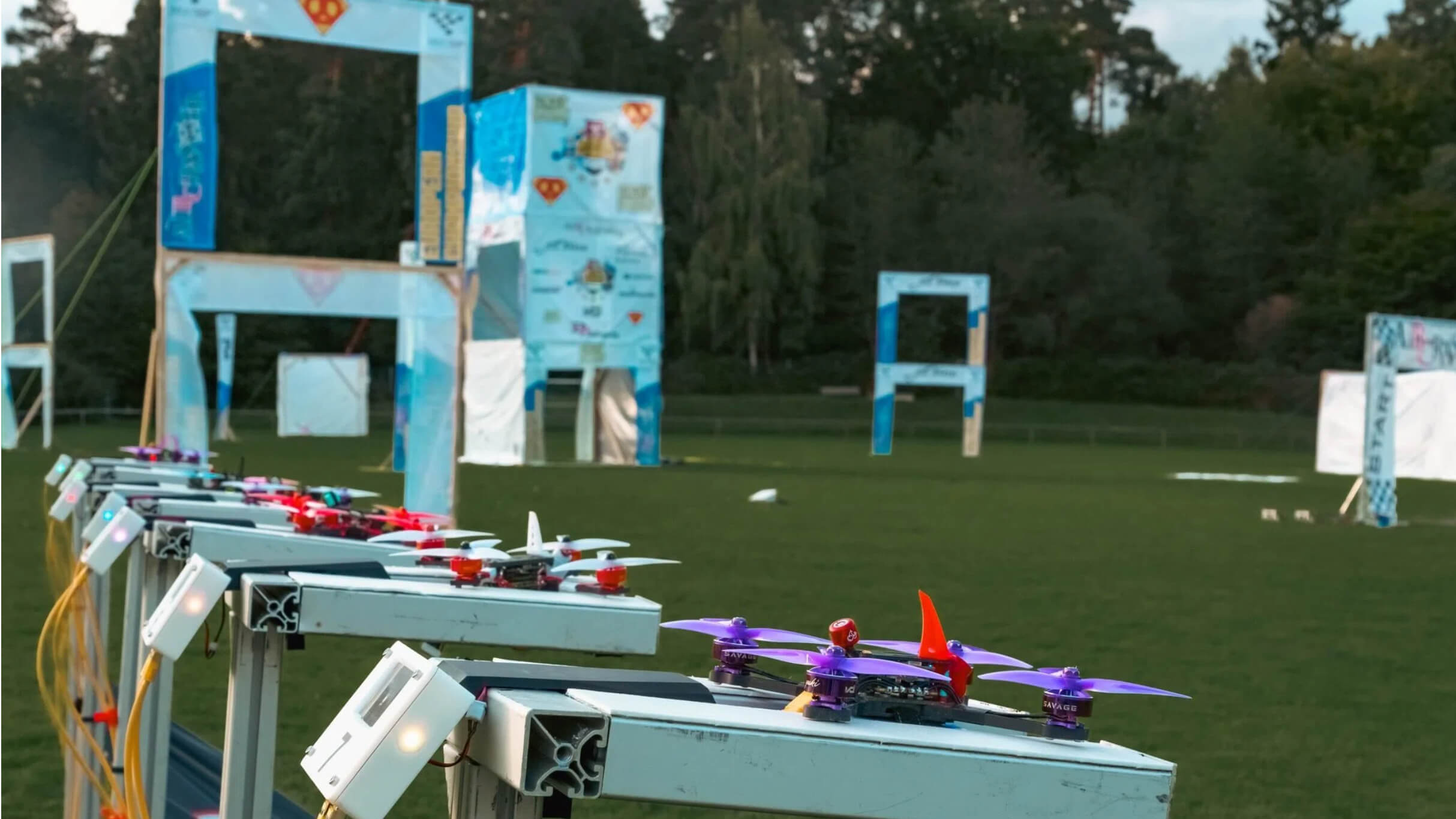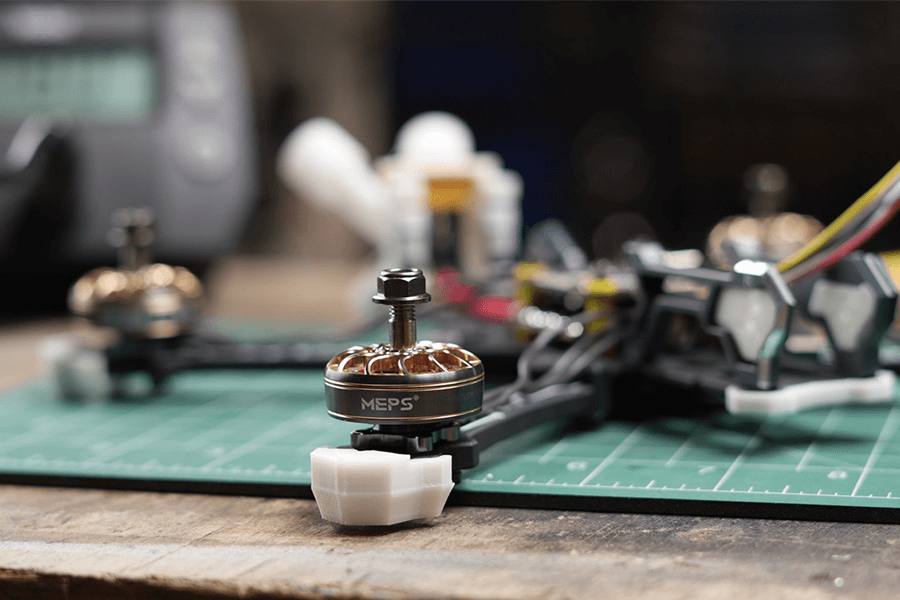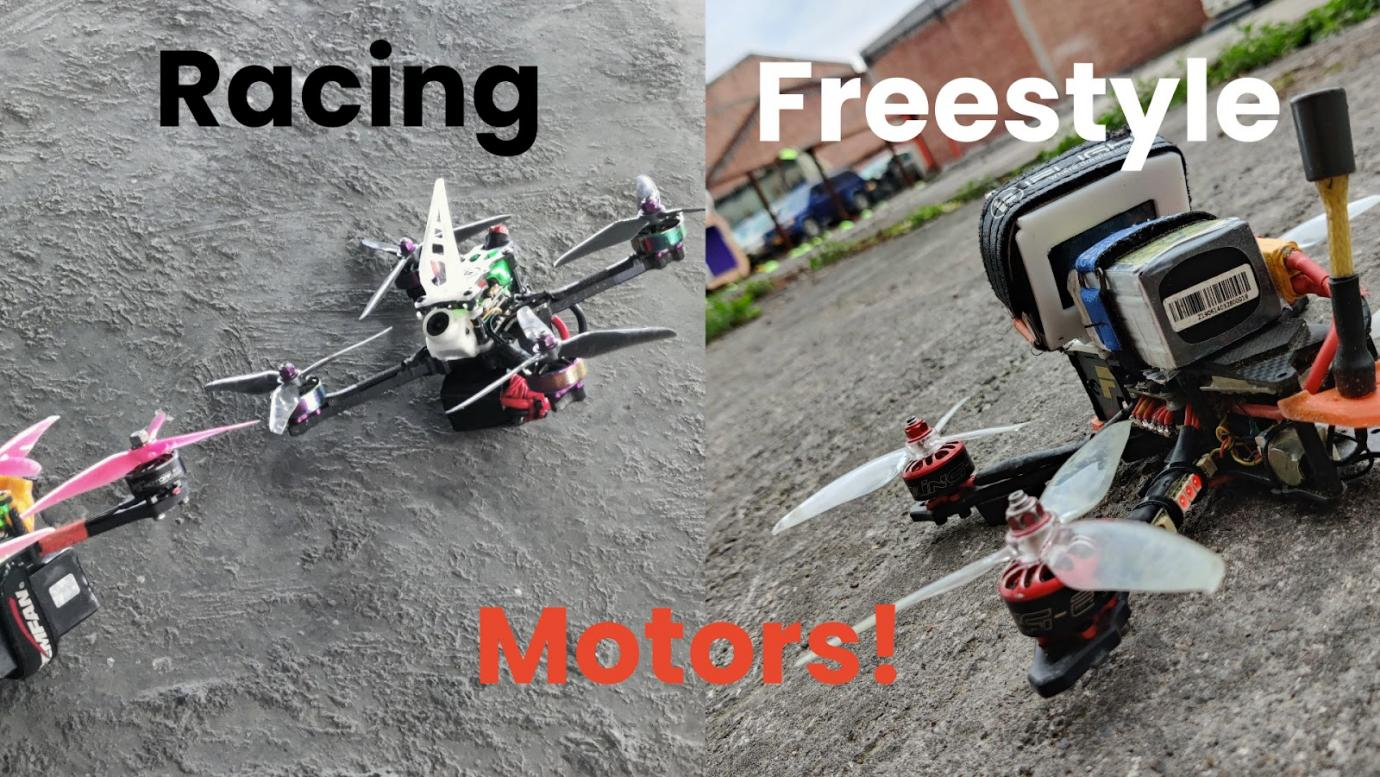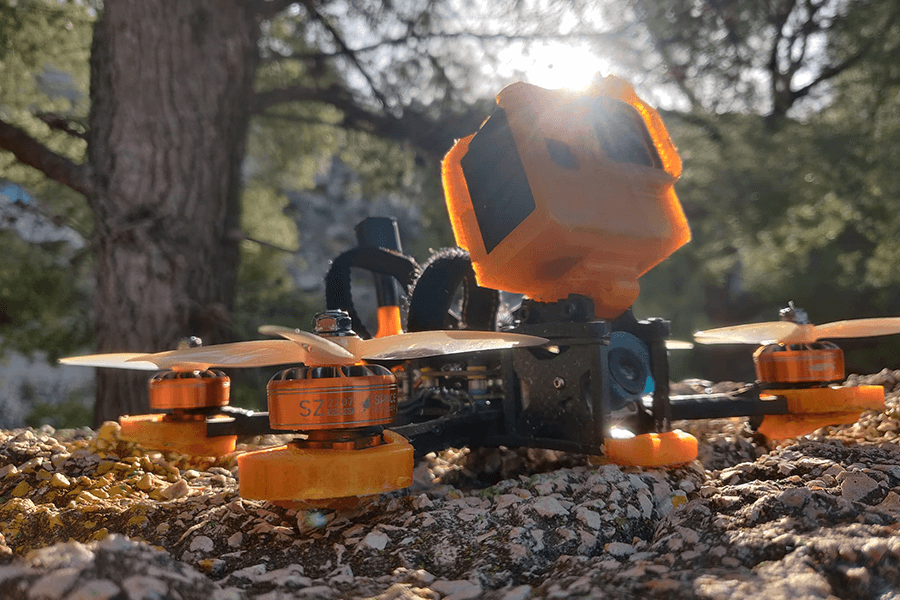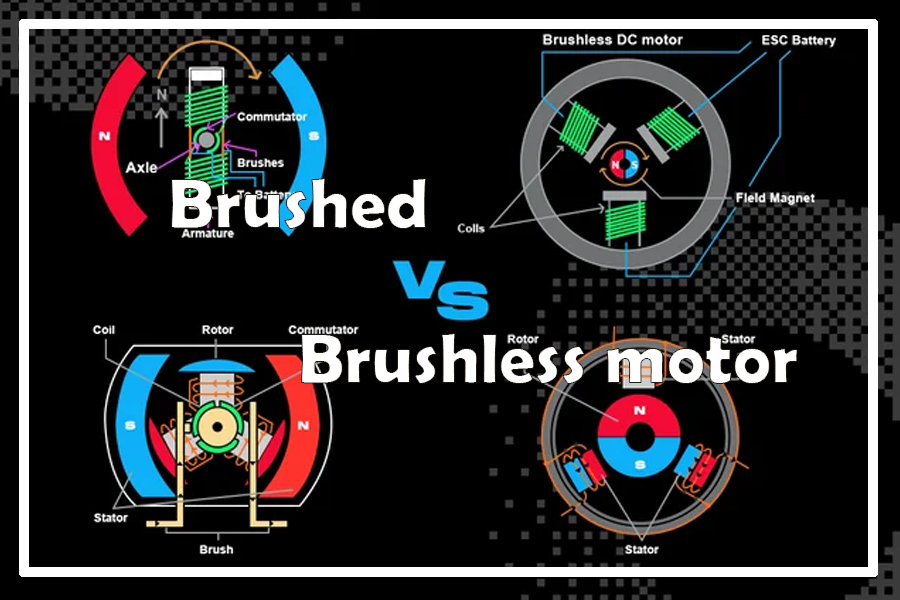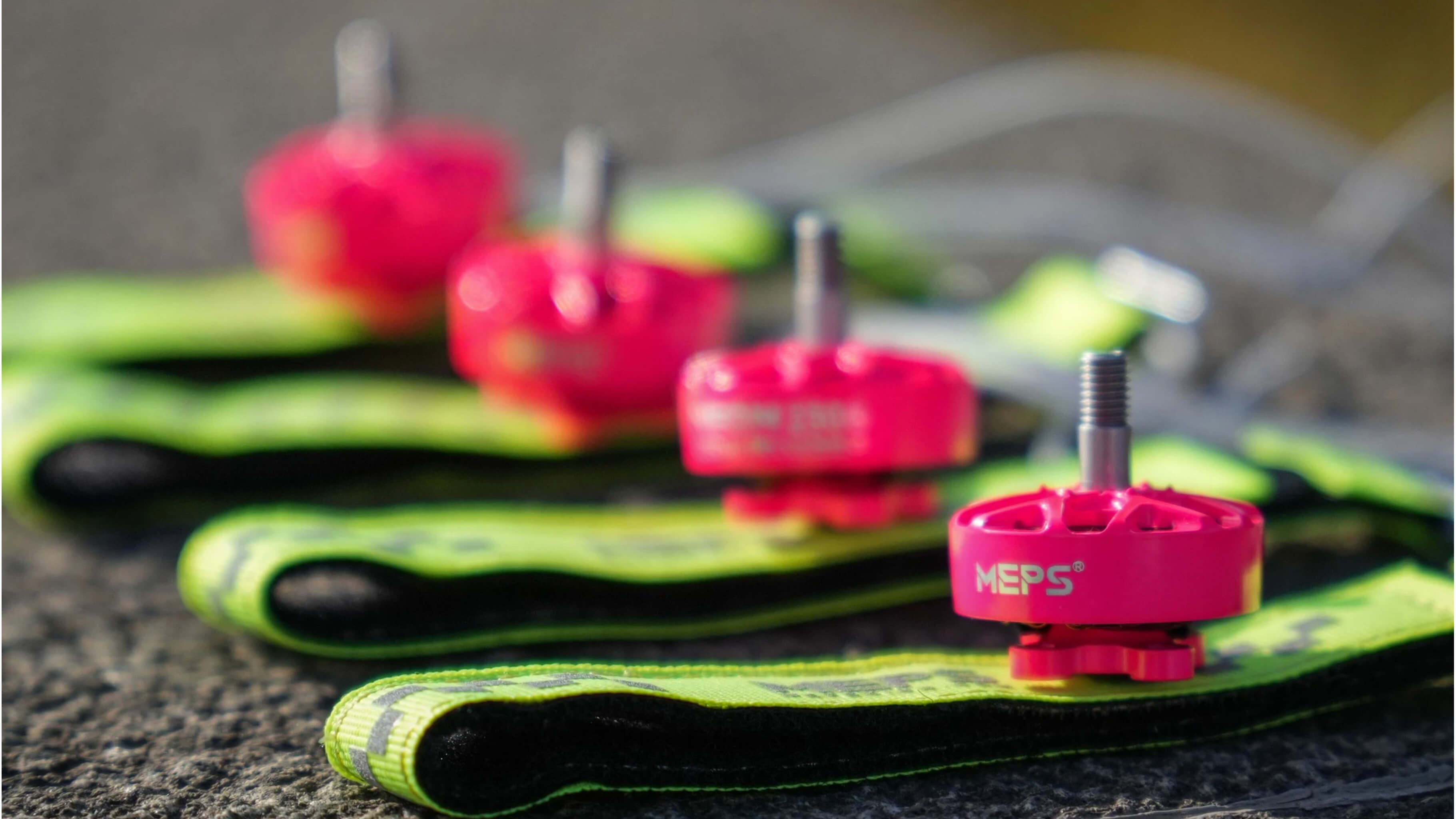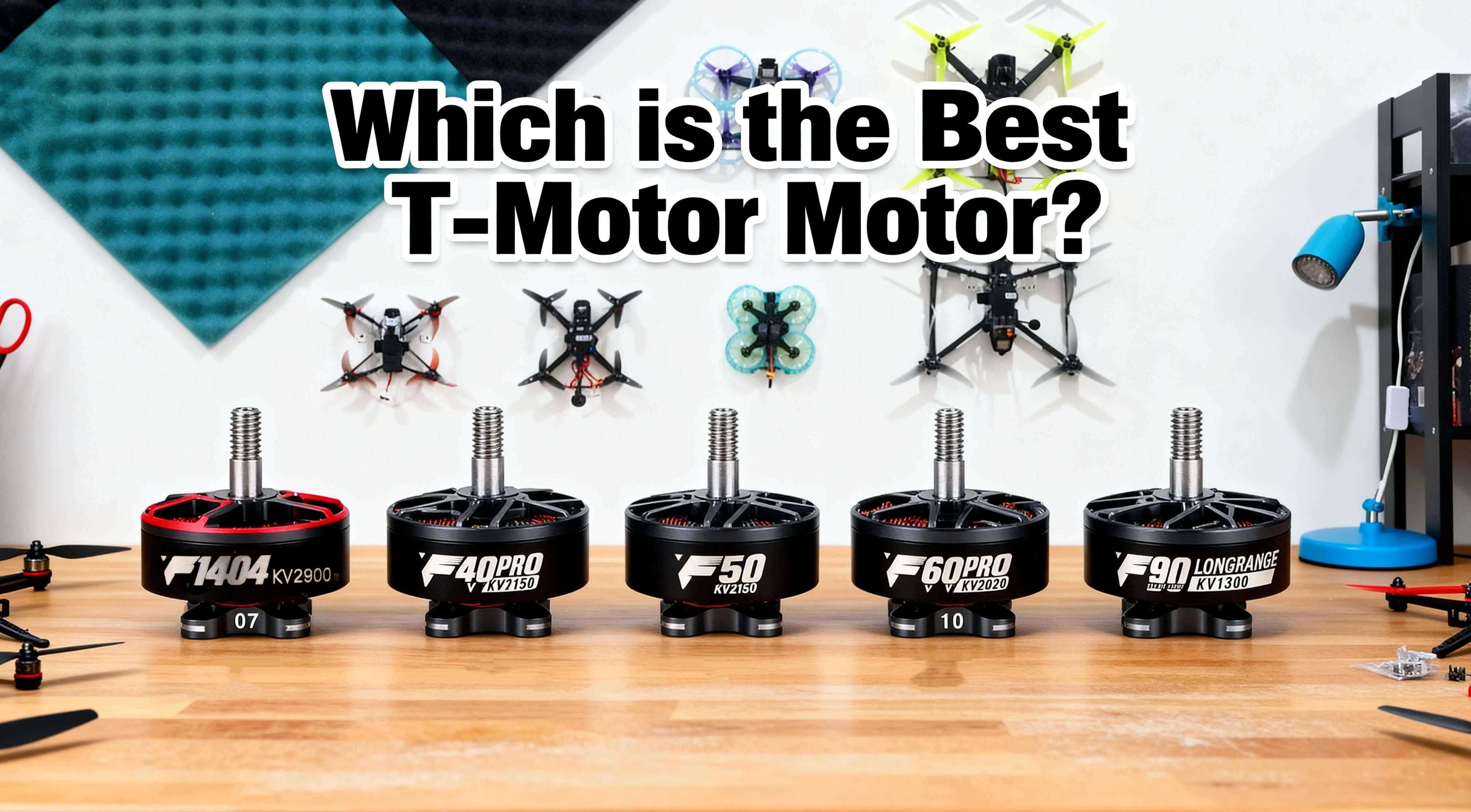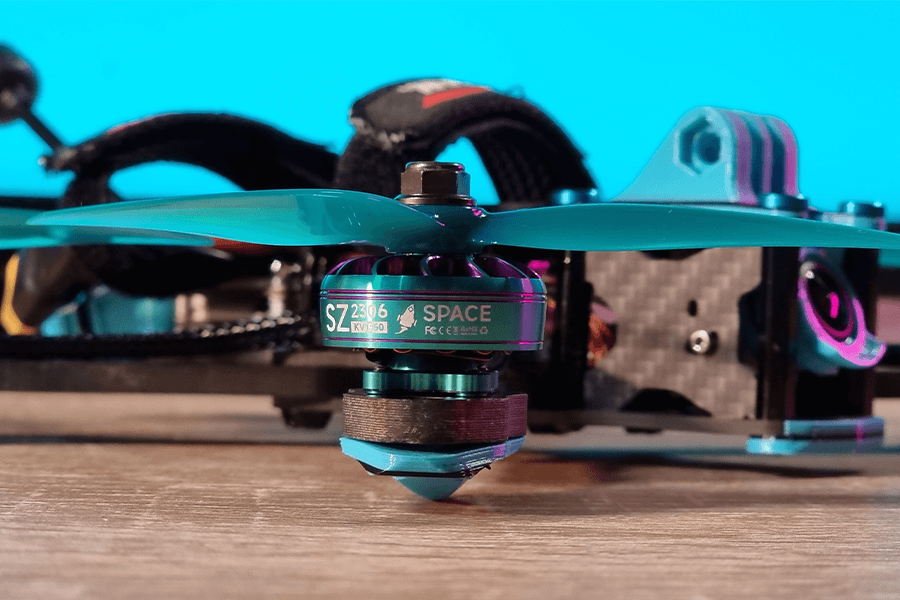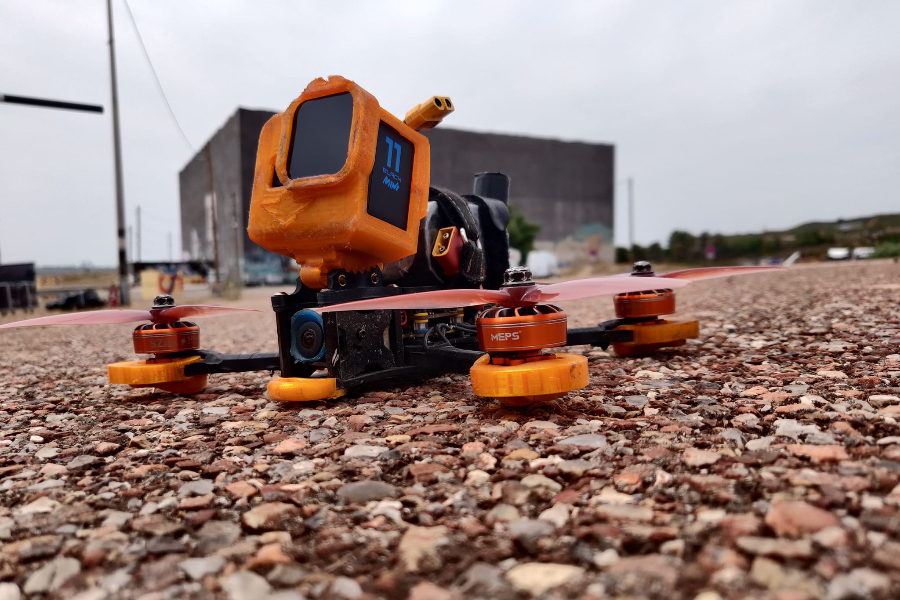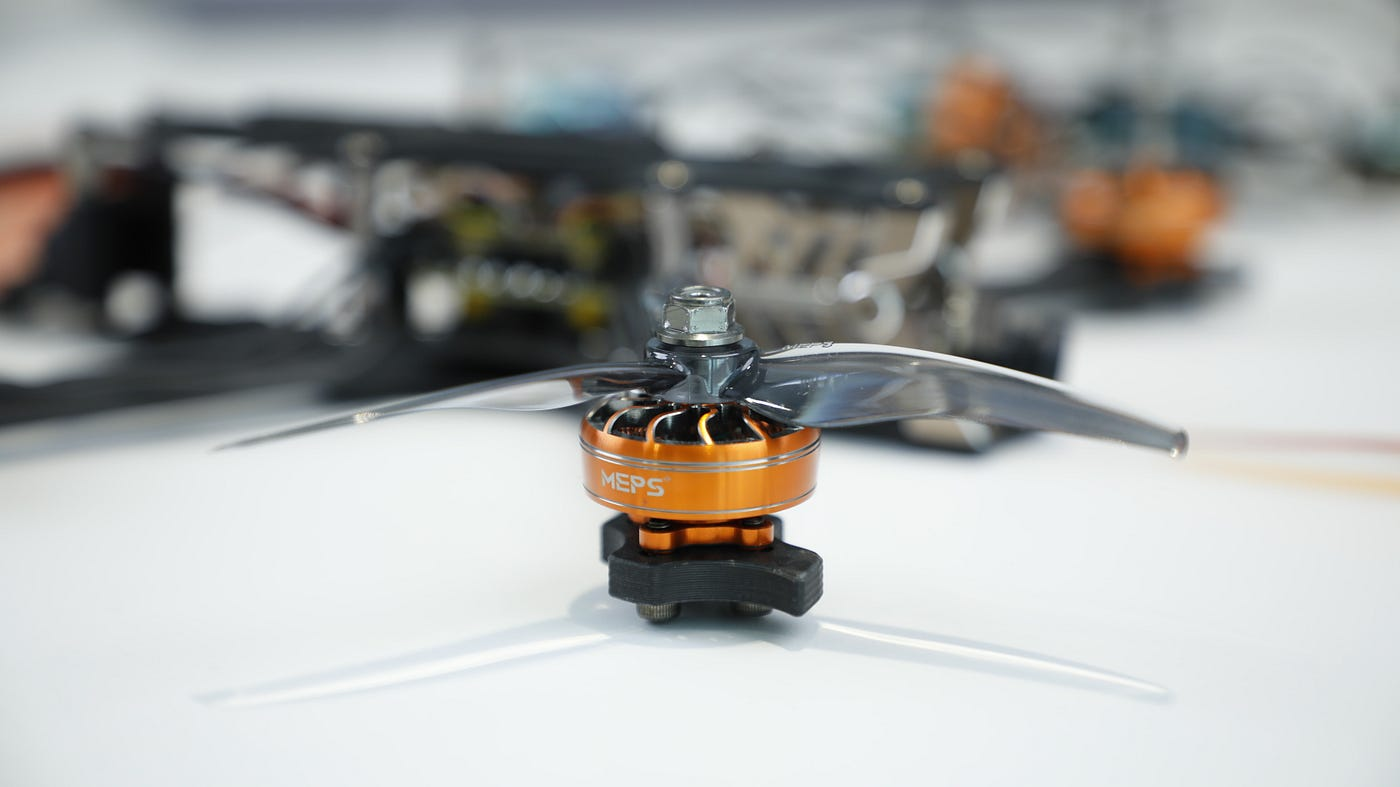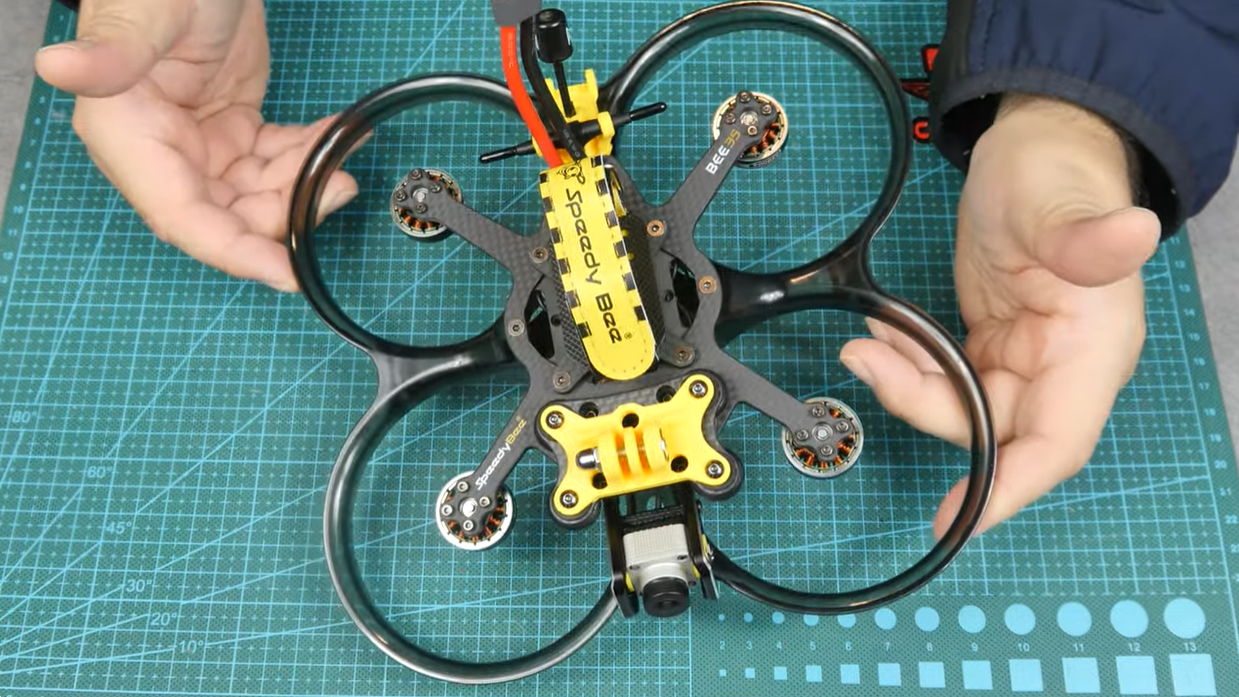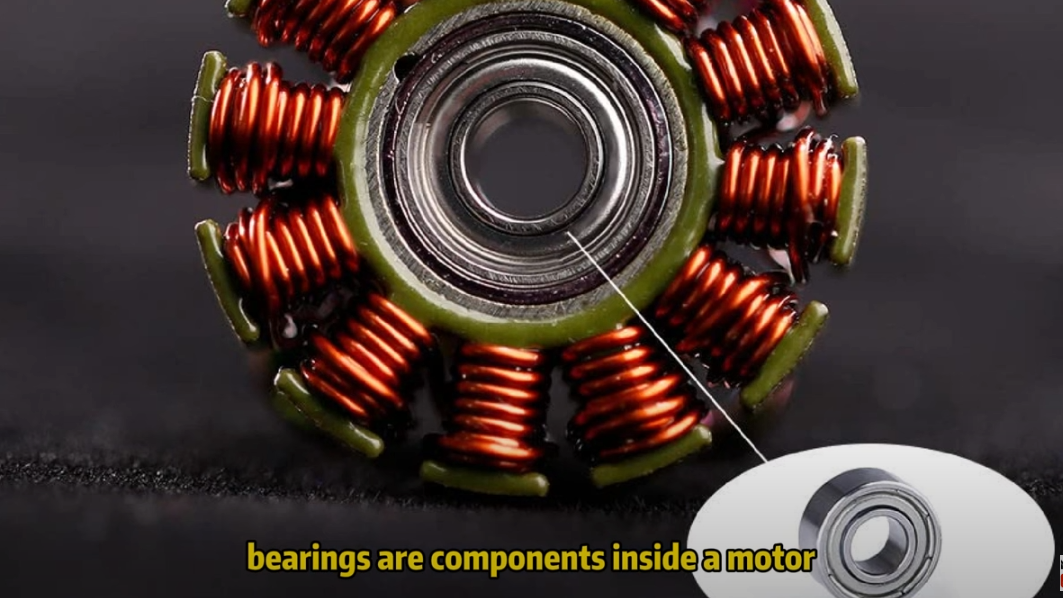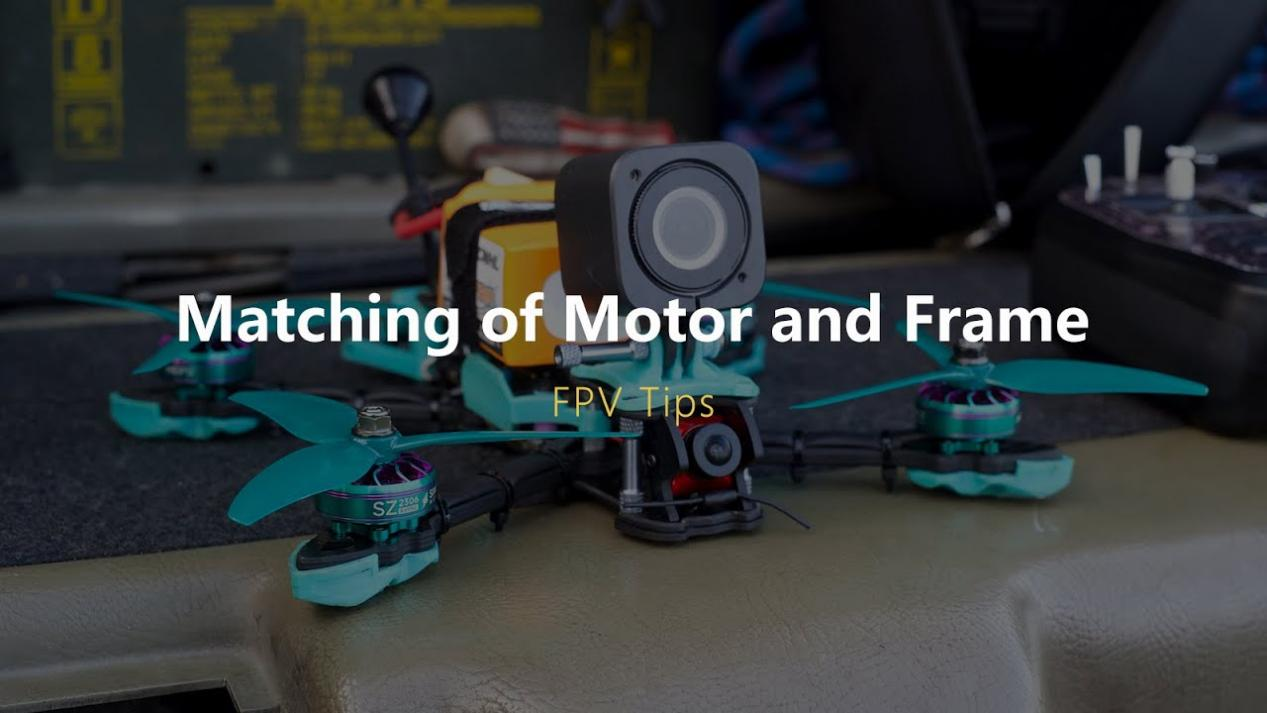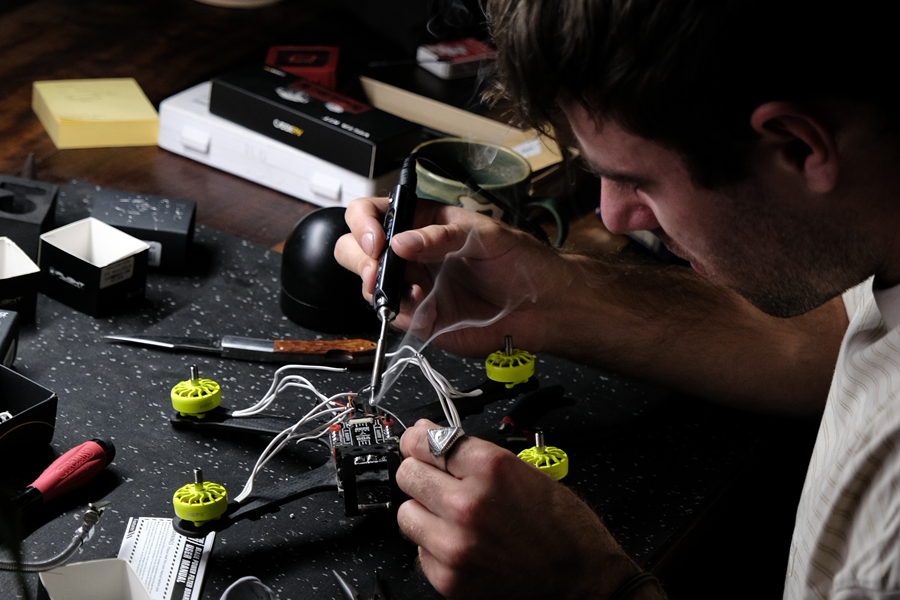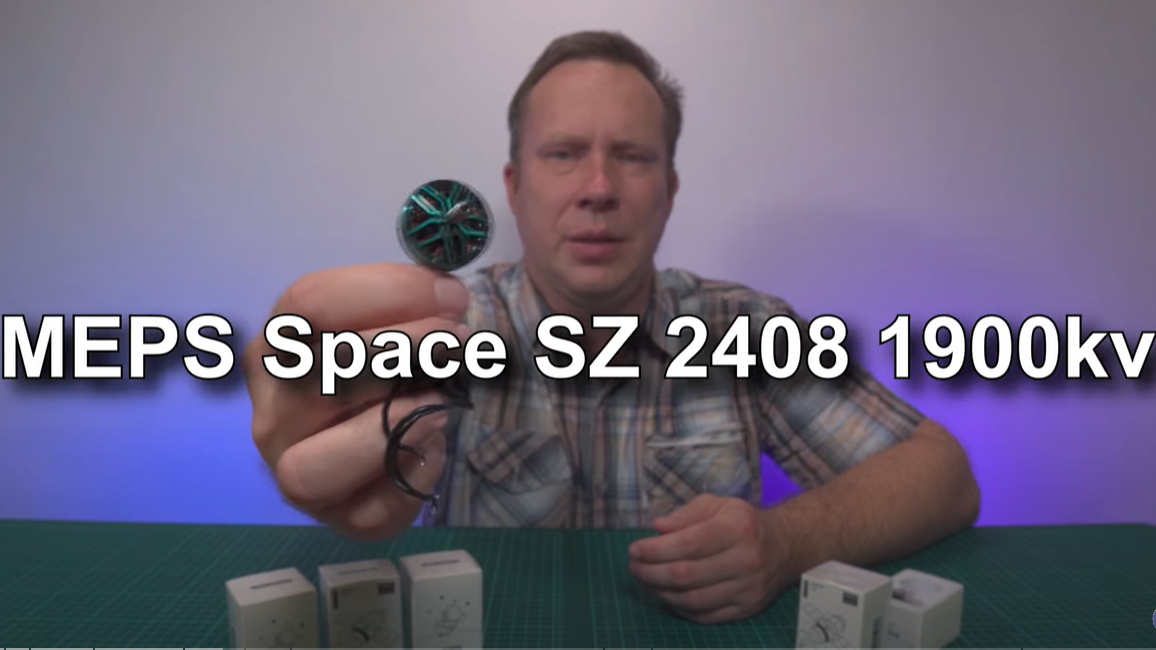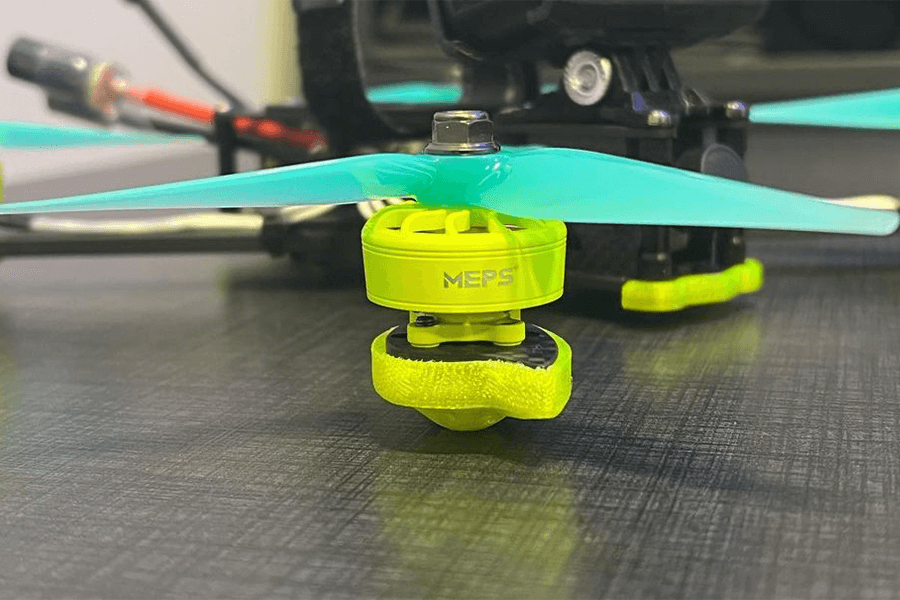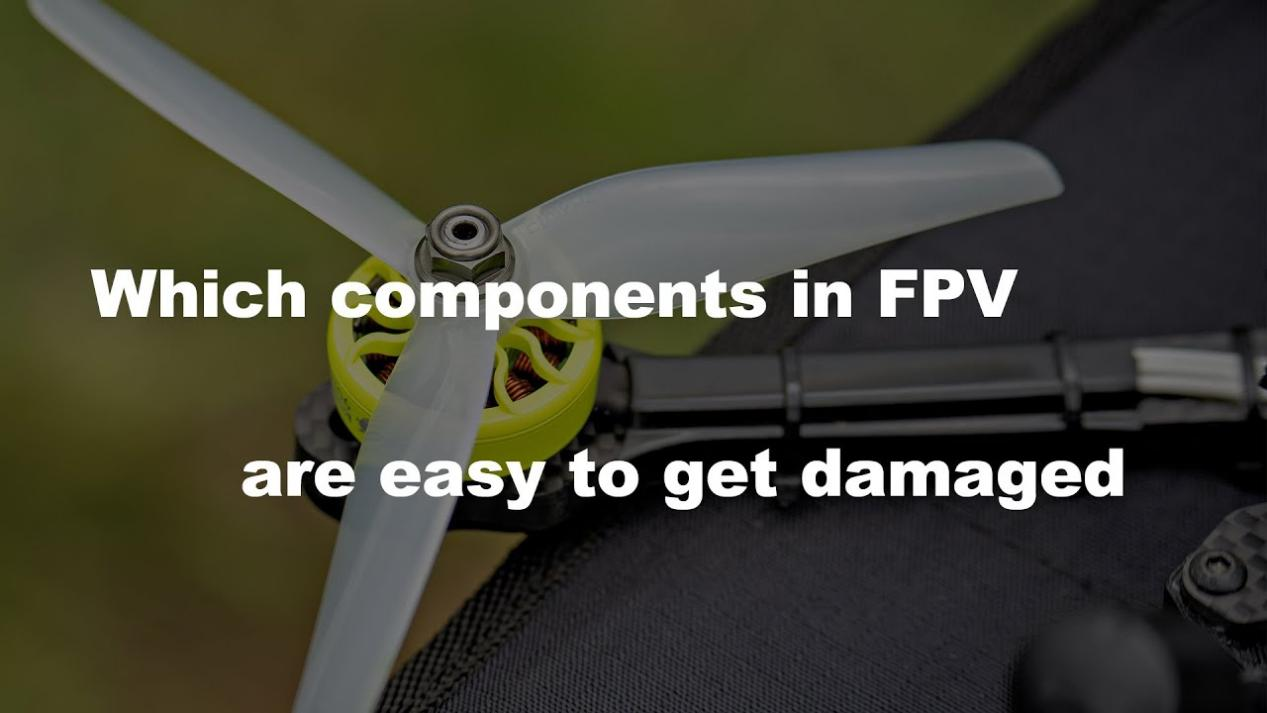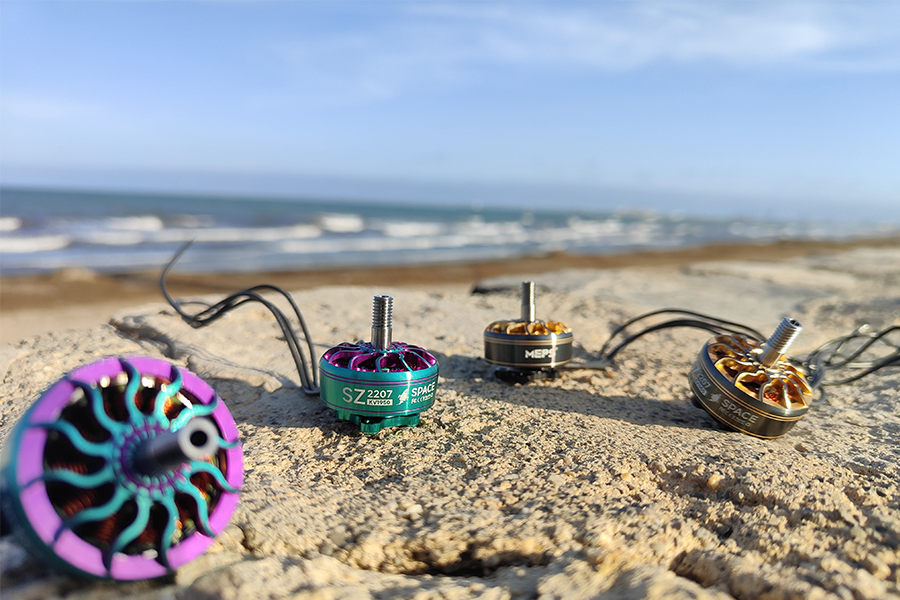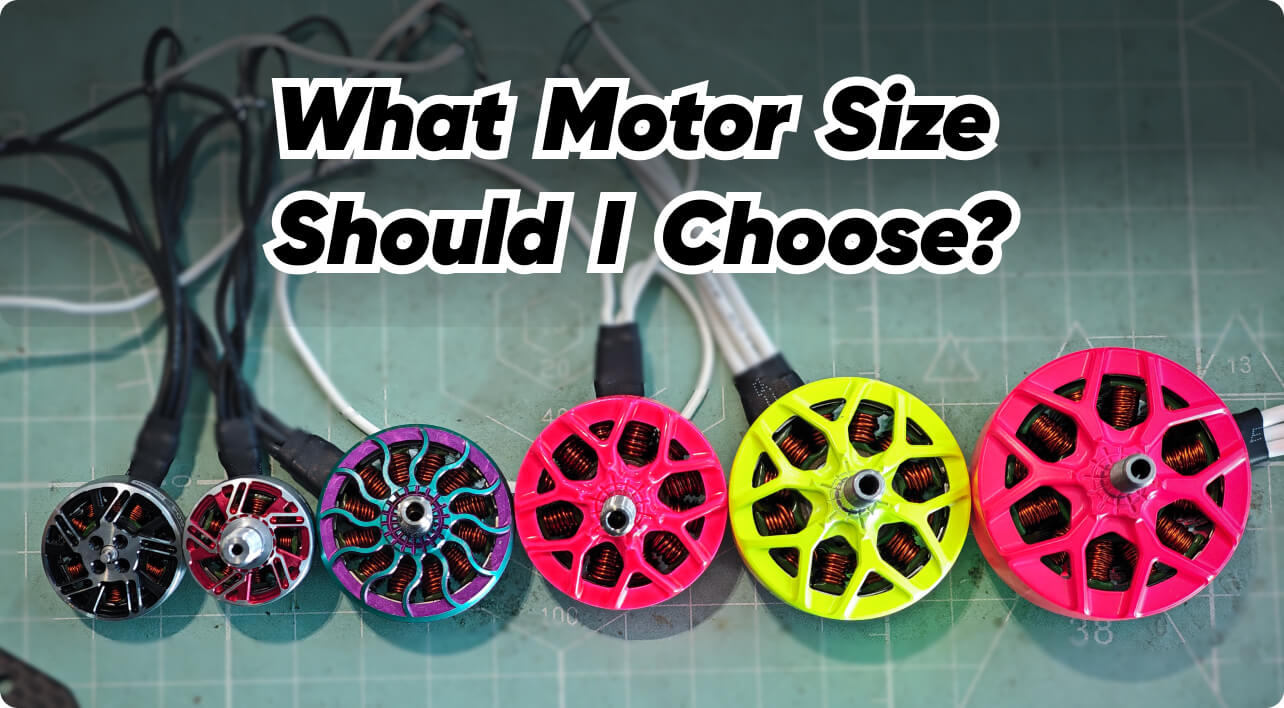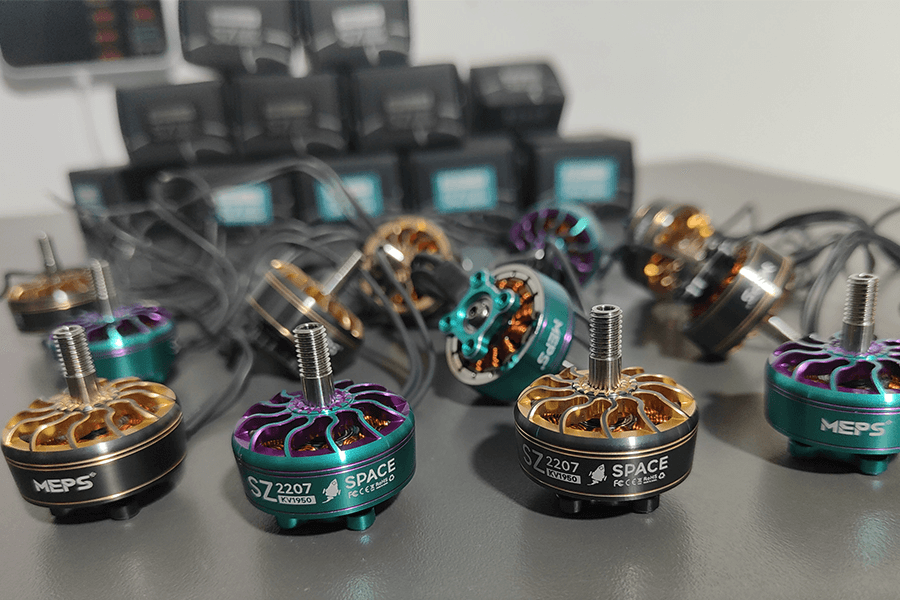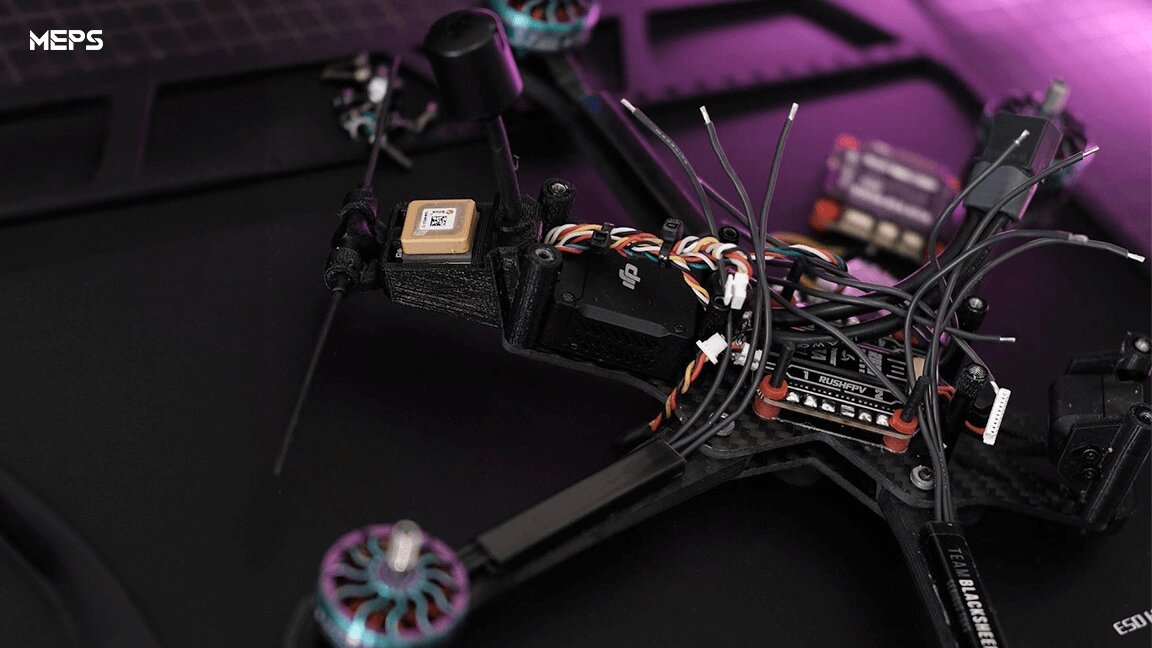-
The Best FPV Racing Drone Motors for Drone Racing (And How to Choose)
If you’re serious about drone racing, motors are not just another part of your build — they are the heart of your entire racing setup. The difference between average lap times and winning heat after heat often comes down to your choice of FPV racing drone motors. FPV racing drone motors must deliver explosive torque through tight gates, maintain high RPM on long straightaways, and respond instantly to Betaflight PID commands. This is precisely why experienced racers focus on racing drone motors that excel in torque output, lightweight construction, and high KV performance. In this guide, I'll recommend three racing motors suitable for pilots from beginners to experts. I’ll also walk you through what actually makes the best FPV racing motors, how experienced pilots choose racing drone motors, and what technical details truly matter when you’re pushing your quad at race pace. This isn’t a spec-sheet summary. This is how racers really choose motors. Best FPV Racing Motors by Skill Level Instead of listing random brand models, it makes more sense to categorize racing drone motors by pilot level. Click here to see the collection of FPV Motors. Best Budget FPV Racing Motors (Beginner Racers) Ideal for pilots entering local races: Affordable to replace… -
FPV Attach Props to Motors (Step-by-Step)
Attaching FPV props to motors is easy if done right. Identify motor rotation (CW/CCW) Match props to correct motors And choose the proper mounting method—prop nuts, T-mount, or press-fit. Align the props on motor shafts, secure them using prop nuts or screws Always check prop orientation, top/bottom, and tightness for safe, stable FPV flights. Why Properly Attaching Props Matters in FPV Builds Correctly installing your FPV propellers is crucial for: Flight performance: Properly attached props reduce vibration and improve thrust efficiency. Safety: Loose props can fly off mid-air, causing crashes or injuries. Component longevity: Correct tension prevents damage to motor shafts and bearings. Whether you’re a beginner or a seasoned FPV pilot, mastering prop installation is a must. See the guide to help you choose the best FPV propellers: Choose Best Suitable Propellers for Your FPV. Tools and Parts You’ll Need Before attaching your FPV props to motors, prepare these tools and parts: A set of FPV propellers (CW and CCW pairs) FPV motors (brushless motors with threaded shafts or T-mounts) Prop nuts or screws (depending on motor type) A prop nut wrench or driver tool: Usually a spanner or socket wrench for 8mm prop tool Safety gear (gloves and goggles) Having the right…- 294
- 0
-
How to Clean Drone Motors?
Keeping your FPV drone motors clean is one of the easiest ways to protect performance and extend motor life. Dust, sand, grass, mud, and even salt can build up inside your motors after only a few flights—especially if you fly freestyle or race in rough environments. A clean motor spins smoother, runs cooler, and maintains maximum thrust. Below is a practical, pilot-tested guide on exactly how to clean FPV drone motors safely and effectively, even after hard crashes, muddy racing sessions, or saltwater exposure. Why is it Essential to Clean Drone Motors? It's likely that you have seen that FPV drone motors are not well protected. The bldc motor windings are clearly visible from both below and above the FPV motor. What May Happen If Not Clean FPV Drone Motors in Time? Here are some incidents that may occur if you do not clean your FPV drone motors in time. Overheating: The FPV motor dissipates heat through clean airflow across it; therefore, if the magnetic surfaces of the rotor are heavily contaminated, the heat may not dissipate effectively. Your motors run hotter than they should as a result of this. Wear and excessive friction: The crushed ceramic particles between the… -
What is Difference Between FPV Racing Motor and Freestyle Motor
When we started flying FPV drones, we had doubts about which motors to use. Sometimes we choose motors that look better without considering the differences between types of motors. This article looks at the different types of motors for FPV drones. We'll look at motors for drone racing and freestyle flights. There are differences between them. We'll also look at the best motors for each type of flight. What are FPV Freestyle Motors? Freestyle motors are built to deliver control, balance, and smooth power output, not raw top speed. Key Characteristics Mid KV (1700–2150KV for 6S 5-inch) Higher torque for quick recovery during tricks Smooth throttle curves for cinematic lines Strong durability for inevitable freestyle crashes Pros of Freestyle Motors Better Control and Stability. Freestyle motors usually have a lower KV rating, providing more torque, which enhances control and stability during complex maneuvers, such as flips, rolls, and smooth transitions. Durability. Freestyle motors are often built with stronger materials and a more robust design to withstand the stresses of aggressive flying and frequent crashes, making them more durable. Smooth Throttle Response. The design of freestyle motors emphasizes a smooth and linear throttle response, allowing pilots to make precise adjustments during…- 469
- 0
-
Top Cinewhoop Motors in 2025: Best Choices for Smooth & Stable Cinematic FPV
Cinewhoop motors are brushless motors specifically designed for cinematic FPV drones, prioritizing smooth, stable, and predictable power delivery over raw speed or agility. They are optimized for carrying the additional weight of an action camera, like a GoPro, and operating quietly within ducted frames. This guide covers the best Cinewhoop motor sizes, ideal KV ranges, technical considerations, and real-world setups so you can build or upgrade the perfect Cinewhoop for 2025. What Makes Cinewhoop Motors Different? Cinewhoops are unique because they operate inside ducts, carry additional camera payloads, and aim for cinematic flight qualities rather than speed. Unlike racing or freestyle quads, Cinewhoops are designed for: Smooth, predictable throttle Low-noise operation High torque at low RPM Stable hover without oscillation Carrying extra payload (GoPro 11, 12, Insta360, Naked cameras) Flying in ducts, which reduces airflow efficiency Because of this, Cinewhoop motors require a different engineering profile: Focus on Stability and Torque: Cinewhoop motors need enough torque to lift the payload smoothly and maintain steady flight, rather than for aggressive maneuvers. Lower to Mid-KV Ratings: Compared to racing drones, cinewhoops use motors with lower KV ratings (RPM per Volt) in order to achieve stable RPMs with higher voltage batteries (e.g., 4S-6S LiPo)… -
Heavy Lift Drone Motors Explained: From Industrial Drones to FPV Cinelifters
What Are Heavy Lift Drone Motors? Heavy lift drone motors are high-power brushless motors specifically designed for drones that need to carry large payloads — typically used in models with total takeoff weights ranging from 2 kg to 100 kg or more. Compared with regular FPV drone or hobby drone motors, huge drone motors feature the following characteristics: Larger stators (130mm or larger) that generate more torque. Low KV → High Torque: Large propellers require greater torque to start and maintain rotational speed. Low KV motors offer a higher torque-to-current ratio, making them suitable for large-diameter propellers. Exceptional thrust — some industrial motors can exceed 60–100 kgf per motor at peak power. Enhanced heat dissipation and durable bearings for continuous heavy-load operation. These large drone motors are widely used in industrial drones, agricultural UAVs, cinematic lifters (cinelifters), and long-range FPV rigs that demand stable thrust and long endurance. Key Features of Heavy Lift Drone Motors Here are the key features of heavy drone lift motors: FeatureDescriptionHigh Torque DesignHeavy lift drone motors use larger stators (typically 130mm or larger), which generate more torque for better thrust and lifting capacity.Low KV RatingWith KV values between 30–800KV, these motors deliver smooth and efficient rotation for large propellers, ensuring stable flight under…- 107
- 0
-
Troubleshooting Guide: Why FPV Motors Getting Hot?
If your FPV motors are getting hot, it’s usually caused by improper tuning, prop mismatch, over-throttling, or insufficient cooling. To fix it, check your PID tune, motor timing, prop size, and ESC settings. Always ensure good airflow and avoid flying on low-efficiency props or overly aggressive rates. Why is it Important to Cool FPV Motor? After a vigorous flight, it's common for FPV motor to get warm, but how hot is too hot? Pinching the engine by the bell with your fingertips—ideally immediately after landing—is a simple technique to find out. It's acceptable if you can comfortably hold your fingers there for more than ten seconds. It may indicate overheating if it gets too hot to handle. When fpv motors overheat, the winding's coating may melt, creating internal electrical shorts that will emit smoke and cause irreversible damage to the fpv motor. Overheating motors can eventually affect performance since the magnets lose their magnetic strength; Certain magnet types may be more heat resistant than others. Heat wastes more energy, which reduces flying duration. How FPV Motors Work? FPV (First-Person View) motors are a crucial component of an FPV drone, responsible for converting electrical energy from the battery into mechanical energy… -
Brushed vs Brushless Motors: Which Is Best for Your FPV Drone
If you’re building or upgrading your FPV drone, choosing between a brushed and brushless motor is crucial. While brushed motors are cheaper and simpler, brushless motors dominate modern FPV builds due to their power, efficiency, and durability. Brushless drone motors have revolutionized the world of brushless electric motors, offering numerous advantages over brushed motors. In this comprehensive guide, we will explore the principle of operation of brushless drone motors, highlighting their key features, benefits, and applications. What are Brushless drone motors? At its core, a brushless drone motor is an electric motor that operates on direct current (DC) with a rotor composed of permanent magnets. Unlike brushed motors, brushless drone motors do not rely on sliding electrical contacts (brushes) on the motor shaft for operation. Instead, the commutation of the current in the stator windings and the resulting variation in the magnetic field are controlled electronically. This design eliminates mechanical resistance, reduces the risk of sparks at high speeds, and significantly minimizes the need for periodic maintenance. How Brushless Drone Motors Operate? The principle of operation of brushless drone motors involves the interaction between the rotating magnetic field generated by the permanent magnets on the rotor and the variable magnetic…- 671
- 0
-
Best FPV Motors in 2025: Top 10 Picks from Beginner to Professional
Choosing the right motor can make or break your FPV drone. Whether you’re a newcomer just learning to hover or a seasoned pilot chasing cinematic perfection, your motor choice directly impacts thrust, control, flight time, and reliability. In 2025, FPV motor technology has reached new heights. Manufacturers are refining magnet layouts, improving stator efficiency, and optimizing weight-to-thrust ratios like never before. Today’s FPV pilots have more motor choices than ever — but that can also make the decision overwhelming. That’s why we’ve put together this comprehensive FPV Motor Guide 2025, featuring the top 10 best FPV motors across four major categories: Beginner, Freestyle, Racing, and High-Performance. Why the FPV Motor You Choose Matters An FPV motor is more than just a spinning part — it’s the powerhouse that defines your drone’s agility and feel in the air. A well-chosen motor provides: Consistent Thrust: Smooth and predictable acceleration. Efficiency: Longer flight times and cooler operation. Durability: Resistance to crashes and temperature stress. Responsiveness: Fast RPM changes for tight control in freestyle or racing. With the FPV scene evolving, 2025 is the perfect time to upgrade your setup — whether for more speed, smoother cinematic footage, or improved efficiency. Entry-Level FPV Motors for Beginners Starting out in…- 214
- 0
-
Best 5 T-Motor Motors for Freestyle, Racing & Long-Range FPV Drone
T-Motor has long been one of the most trusted brands in the FPV world. Whether you’re building a freestyle beast, a racing rocket, or a long-range cruiser, T-Motor offers a motor for every flying style. In this guide, we compare the 5 best T-Motor FPV motors — covering performance, durability, and real-world flight feedback. If you want to learn more about the FPV motor, check the guide: How to Choose FPV Drone Motor A Detailed Guide Quick Comparison Overview of T-Motor Motors MotorKVDimensions (mm)Weight (g)Voltage RangeMax Current (A)Max Power (W)Recommended PropsT-Motor F14042900 / 3800 / 4600Ø17.9×16.69.343–6S10.45–20262–3163”–4” (Gemfan 3025, HQ 3x2x3)T-Motor F40 PRO V1950 / 215027.8×31.433.7–34.56S55.5–65.61354–15915” freestyle (T-Motor 5143, Ethix P3)T-Motor F502150 / 2200Ø27×29.528.36–28.566S54.8–56.631273–13155” racing (Gemfan 5143, HQ 5x4.3x3)T-Motor F60 PRO V 1750 / 1950 / 2020 / 255026.8×31.733.3–34.34–6S40.5–52.7825–12975” racing/freestyle (HQ 5x4.3x3, Gemfan 5143)T-Motor F901300 / 1500 / 1950Ø33.4×34.746.6–46.75–6S45.1–53.61059–13027” long-range (Gemfan 7042, HQ 7x4.2x3) Choosing the right T-Motor setup is easier when you have real pilot insights. Through the MEPSKING VINE VOICE program, FPV pilots test motors across freestyle, racing, and long-range builds — sharing genuine flight impressions, durability reports, and performance feedback. T-Motor F1404 Motor for Micro FPV Drones Key Specs: Motor Dimensions: Φ17.9*16.6mm Lead: 24#AWG 150mm Shaft Diameter: 1.5mm Idle Current…- 165
- 0
-
How to Rotate FPV Motor Direction?
Your FPV drone cannot fly if even one motor spins in the wrong direction — motor rotation is absolutely critical for stable flight. But how can you reverse your FPV motor direction safely and effectively? There are two main ways to change the direction of your FPV motor: Hardware solution: swap the motor wires connected to the ESC. Software solution: adjust settings in your flight controller or ESC configuration software (such as Betaflight or BLHeliSuite). This comprehensive 2025 guide explains each method step-by-step, helping you understand not only how to rotate your FPV motor but also why it matters for drone stability, control, and flight performance. Before adjusting motor direction, it's helpful to learn from real pilots who’ve tested different motors and setups. Through the MEPSKING VINE VOICE program, FPV pilots receive free parts to test and share authentic build notes— including motor direction settings, ESC configuration tips, and troubleshooting experience. Click the image below to know more details. What are the types of FPV motor rotation direction? FPV motors can rotate clockwise (CW) or counterclockwise (CCW). This determines how the propellers push air and affects flight balance. In FPV drones, propeller rotation configurations are classified into two main types:…- 1.2k
- 0
-
What is the best fpv drone under $200 in 2025?
Entering the world of FPV (First-Person View) doesn’t have to cost a fortune. Whether you’re just starting your FPV journey or looking for a backup drone for practice, there are plenty of budget FPV drones under $200 that deliver impressive performance, durability, and flight experience. In this guide, we focus on two cost-effective FPV builds: 2.5-inch Cinematic Drone 5-inch Freestyle Drone Websites And Economic Fpv Drone Components Let's start by listing the websites where you can purchase materials for our budget-friendly build. Unfortunately, there are fewer sites with excellent prices, but fortunately, there are still some available. For materials for a budget build, you should consider purchasing from the following sites: Mepsking.shop: This site offers great prices on stacks and motors. It's a good option to consider once you've chosen the frame to buy stacks and motors that are compatible with that frame. Stonehobby.com: Excellent for choosing receivers, video systems, GPS, buzzers, etc. This site offers the best prices. Aliexpress.com: It provides a wide selection of budget-friendly frames. Banggood.com: While it used to be an excellent e-commerce platform, unfortunately, it now offers very few items at a good price. Prices have also increased on this site for other products. In…- 945
- 0
-
Review of MEPS SZ2207 FPV Brushless Motor by Whirly Bloke
If you’ve been in the FPV hobby for a while, you’ll know that finding the perfect 5-inch motor is like chasing the ideal tune—everyone has their own preference, and there’s always something new to try. This time, I got my hands on the MEPS 2207 motor 1750KV FPV brushless motor, and after a few weeks of flying it hard on both freestyle and long-range setups, I can safely say—it’s an impressive motor that deserves attention. Unbiased Evaluation Before diving in, it's important to note that I haven't signed any contract with MEPSKING, nor have they influenced this review. They simply provided the drone motors for evaluation, and I'll be offering my unbiased opinion, as with all product reviews on my channel. First Impressions Out of the box, the MEPS 2207 1750KV looks premium. The machining is clean, the bell design is sleek with good ventilation, and the overall finish feels solid. MEPS has done a great job making these motors look as good as they perform. The motor comes in a tidy package, complete with mounting screws and a matching color scheme that gives your build a clean, professional touch. At first glance, it’s clear that MEPS isn’t just trying…- 428
- 0
-
How to Build a 3.5″ Cinewhoop Drone (Step-by-Step Guide)
Building a cinewhoop drone starts with choosing a solid cinewhoop frame like the SpeedyBee Bee35, pairing it with reliable MEPS SZ2004 motors, and configuring it in Betaflight. This step-by-step guide walks you through assembly, wiring, and setup so you can create one of the best cinewhoop options for stable cinematic footage. Part List (Recommended Setup) Frame: SpeedyBee Bee35 3.5-Inch Cinewhoop Frame Motors: MEPS SZ2004 Motor for 3.5″ Cinewhoop Drone Stack (FC + ESC): SpeedyBee F405 Mini BLS 35A 20x20 Stack Camera & VTX: RunCam Link Phoenix Receiver: RECEPTOR ELRS GEPRC NANO ( 2.4GHZ PA100) Battery Plug: XT60 Propellers: 3.5″ tri-blades (more pitch if carrying GoPro) Tools You’ll Need Allen Wrenches: 2.0mm and 1.5mm (for frame and motor screws) Soldering Iron: TS100 or equivalent Solder & Flux: For clean, solid joints Heat Shrink Tubes & Electrical Tape: Cable protection USB Cable: For Betaflight connection Initial Impressions and Flight Test The Bee35 cinewhoop frame feels sturdy and well thought-out. With ducts for safety and vibration-damping TPU, it’s an ideal base for building a reliable cinewhoop drone. In flight tests, the quad felt locked-in and agile, especially without a GoPro. Once you add a GoPro, switching to higher-pitch props helps balance agility and…- 578
- 0
-
FPV Motor Bearings: How to Check Damage and Replace Them?
As an FPV pilot, keeping your FPV motor bearings in top shape is key to smooth, stable flight. Damaged motor bearings can cause: Unusual vibrations or buzzing Reduced thrust and control precision Mid-air instability or crashes Key points to maintain and repair: Inspect bearings regularly for wear or damage. Understand common causes of motor bearing failure. Perform motor bearing replacement when needed. Keep your FPV drone running safely and efficiently. Mastering these steps ensures your drone flies reliably, protects your motors, and improves flight performance. What Are FPV Motor Bearings and Why They Matter? Brushless FPV motors use tiny high-speed motor bearings to support the rotor and reduce friction. They’re the unsung heroes of your powertrain. Good bearings keep the motor spinning true, generating smooth thrust and precise control. When they wear out, friction increases, causing heat buildup, power loss, and wobble. Even a slightly rough bearing can destabilize your quad during high-speed maneuvers. See More: What is the Structure of Drone Motor? Signs Your FPV Motor Bearings Are Damaged Here’s how I spot bad bearings before they ruin a flight: Grinding or scratching noise when spinning motors by hand Vibration in goggles footage even after balancing props Loose or…- 631
- 0
-
MEPS Motors Buy Guide: Choosing the Right Drone Motor Size for Your FPV Build
Choosing the right motor size is one of the most important decisions when building or upgrading an FPV drone. The motor directly impacts flight performance, efficiency, stability, and overall flying experience. A mismatched motor can lead to overheating, reduced flight time, or poor control response. This article is a comprehensive buyer’s guide. It helps you make informed decisions based on frame size, flying style, and budget, providing actionable advice for purchasing the right MEPS motor. Here is a more detailed guide on sizing calculations and performance metrics: What Drone Motor Sizes Do I Need for My FPV? MEPS Motor Size Guide by Frame Size Frame SizeRecommended MEPS MotorTypical Prop SizeFlying StylePerformance HighlightPilot Level65–75mmMEPS 0802 motor31–40mmIndoor WhoopLightweight & High-KVBeginner1.6–2 inchMEPS 1103 motor40–50mmMicro OutdoorEfficient & SmoothBeginner / Intermediate2.5 inchMEPS 1404 motor55–65mmAgile / CinematicPrecise & LightIntermediate3–3.5 inchMEPS 1804 / 2004 motor65–75mmFreestyle / GeneralBalanced Thrust & ControlIntermediate5 inchMEPS 2207 / 2306 motor5-inchRacing / FreestyleHigh Torque / SmoothIntermediate / Advanced6 inchMEPS 2408 motor6-inchCinematic / Mid-rangeStable & EfficientAdvanced7 inchMEPS 2806.5 motor7-inchLong-Range / CinematicEndurance & SmoothAdvanced Recommended MEPS Motors by Flying Style Racing and Freestyle FPV drone motor (5-inch quads) For 5-inch drones, MEPS offers the SZ2207 motors and SZ2306 motors. While similar, the 2207 is ideal…- 735
- 0
-
How to Choose FPV Drone Motor A Detailed Guide
In every multirotor drone, the motor is the driving force that spins the propellers and makes flight possible. Within the FPV (First-Person View) community, motors are often considered the “heart” of the aircraft, as even small design differences can have a noticeable impact on weight, responsiveness, efficiency, and overall power. In other words, the choice of FPV motors plays a decisive role in how your quadcopter will perform in the air. Before selecting a motor, one of the first steps is to estimate the total weight of your drone. This includes not only the frame but also essential components such as the frame, flight controller, PDB, cables, drone motors, drone esc, batteries, fpv camera and transmitter, and other components. Along with weight, the size of your frame determines the maximum propeller size you can use, which directly affects the level of thrust your motors need to generate. With these two key pieces of information—drone weight and frame size—you can begin narrowing down your motor options. In the sections below, we’ll explore the fundamental motor parameters and practical considerations that will help you choose the right setup for your FPV build. Introduction to FPV Drone Motors What is FPV Drone Motor?…- 3.3k
- 0
-
MEPS 2408 1900KV Motor Review: A Comprehensive Overview
When it comes to building a reliable FPV drone, the choice of motor can make or break your flight experience. Among the different options available, the MEPS 2408 motor has gained attention for its strong torque, smooth performance, and durability. Designed with freestyle and cinematic pilots in mind, this motor provides an excellent balance between raw power and stable control. In this review, we will take a closer look at the specifications, performance tests, flight experience, and overall value of the MEPS 2408 1900KV drone motor, and compare it with popular alternatives like 2207 and 2306 motors. Unboxing and First Impressions Upon unveiling the MEPS 2408, we're greeted with a robust and meticulously designed motor. The package not only includes the motor but also a variety of accessories to ensure a seamless installation. Inside, you'll find: A quality assurance card A moisture-absorbing gel bag An accessory bag containing: Two sets of screws (short and long), An aluminum nut for the shaft retainer, A metal ring and silicone spacer (or damper) The attention to detail in packaging and the inclusion of essential accessories right out of the box is commendable. Specifications and Features The MEPS Space SZ 2408 motors come in…- 300
- 0
-
How to Calculate Drone Motor Thrust?
Drone motor thrust determines how much lift and maneuverability your FPV drone has. Use a FPV motor thrust calculator or drone motor thrust chart to estimate the required thrust based on drone weight, flight style, and prop/battery setup. Aim for a 2:1 TWR for smooth hover, 3–5:1 for freestyle, and 4–5:1+ for racing. Balance motor KV, prop design, and battery voltage for optimal performance. What is a BLDC Motor? A BLDC (Brushless DC) Motor has no brushes. The rotor and the stator are the two distinct parts that make up a brushless motor. BLDC Motors have revolutionized the world of electric motors, offering numerous advantages over their brushed motor. In this comprehensive guide, we will explore the principle of operation of brushless DC motors, highlighting their key features, benefits, and applications, whether you are an enthusiast looking to build your own drone or someone interested in understanding the inner workings of these motors. What is BLDC Motor Thrust? Thrust is a reaction force described quantitatively by Newton's third law. When a system expels or accelerates mass in one direction, the accelerated mass will cause a force of equal magnitude but opposite direction to be applied to that system. The force…- 5.6k
- 0
-
Which Parts of FPV Drone are Most Likely to Break and How to Protect Them?
Flying FPV drones is thrilling, but let’s be honest—crashes are part of the game. Whether you’re a beginner still practicing or an experienced pilot pushing limits, you’ll eventually face broken parts. Knowing which FPV drone parts are most likely to break (and how to fix them) will save you money, time, and frustration. This guide covers the top components that usually fail, why they break, and how you can repair or replace them efficiently. Which FPV Drone Parts are Most Likely to Break? Propellers Propellers are the most susceptible to breaking, especially on 5-inch quadcopters or long-range FPV drones. Without any protection, they're prone to breaking upon impact. However, cinewhoop drones with protected props are less fragile. Fortunately, propellers are inexpensive and easy to replace, making it a simple fix if one gets damaged. Detailed guide on: Tutorial Propellers: Choose Best Suitable Propellers for Your FPV Why they break: Props take the first hit in almost every crash. Hard landings, tree branches, or concrete surfaces can easily chip or bend them. How to check: Look for cracks, bends, or unusual vibrations during flight. Fix/Replace: Props are inexpensive—replace them rather than repair. Always keep spare sets in your field bag. Motors… -
What is the Structure of Drone Motor?
Basics of FPV Drone Motor--What's a Brushless Motor The power needed for our FPV drone to fly is provided by motors. In essence, it is the force, energy, or impetus behind those drones that has the biggest impact on each quadcopter's flight characteristics. Here, even a slight modification to the design arrangement has a noticeable effect on how responsive a quadcopter is. The majority of fpv drone motors are known as brushless motors because they spin the motor by using three-phase power to drive electromagnets. What exactly is electromagnetic now? It is essential to the operation of bldc motor, both brushed and brushless, because it facilitates the transformation of electrical energy into kinetic energy. The motor rotates as a result of the electromagnet's or permanent magnets' combined attraction and repulsion. Next, we are going to learn FPV motor components. If you want to learn more about how to choose a brushless motor, read this guide on How to choose fpv drone motor a detailed guide FPV Drone Motor Components Stator Brushless FPV drones are just what the name suggests—they lack brushes. The rotor and the stator are its two main motor components. The motor's stationary component, known as the stator (windings), is…- 1.6k
- 0
-
What Drone Motor Sizes Do I Need for My FPV?
Considerations for Drone Motor Sizes When Choosing a Drone Motor Choosing the right drone motor sizes is essential for optimizing your FPV drone's performance, whether you're aiming for speed, agility, or stability. Drone motor sizes directly impact the drone's power, efficiency, and overall flight characteristics. Understanding the differences between various motor sizes will help you make an informed decision that aligns with your specific flying needs, from racing to freestyle or cinematic flying. The right drone motor sizes depend on your frame and propeller size: 3" drones → 1404–1505 motors 5" freestyle/racing drones → 2207 or 2306 motors 7" long-range drones → 2507–2806.5 motors In short: smaller motors (06xx–14xx) suit micro builds and whoops, while mid-size motors (22xx–23xx) power most 5" FPV drones, and larger motors (25xx–28xx+) are for long-range or heavy-lift platforms. Matching motor, prop, and battery ensures efficiency, thrust, and flight performance. This guide explains how drone motor sizes relate to frame, prop, KV, and battery voltage—so you can confidently pick the best FPV motor for racing, freestyle, cinewhoop, or long-range flying. If you want to learn more about how to choose a drone motor, read this guide on How to choose fpv drone motor a detailed guide…- 6.5k
- 0
-
What is KV in Motor: A Beginner’s Guide to FPV Motor Ratings
When choosing a motor for your drone, RC car, or other brushless applications, one of the most important specifications you’ll encounter is KV rating. Beginners often get confused about what KV means, how it’s measured, and which KV is the right choice for their build. In this comprehensive guide, we’ll explain everything you need to know about motor KV: What KV means in brushless motors How KV is calculated The difference between high KV vs low KV motors How KV affects speed, torque, and efficiency How to choose the right KV motor for drones Common misconceptions about KV rating FAQs to answer the most common questions By the end of this article, you’ll clearly understand how KV impacts performance—and you’ll know how to select the right motor for your FPV drone or RC project. What is KV of motor? When a motor is given 1V (one volt) without any load (such as a propeller attached to the motor), the number of revolutions per minute (rpm) that the motor rotates is "KV". For instance, without propellers installed, a 2300kv brushless motor running on a 3S LiPo battery (12.6V) will rotate at about 28,980 RPM (2300 x 12.6). Usually, the motor manufacturer…- 1.9k
- 0
-
What are the Parts of FPV Drone?
Hey there! When you want to learn more about FPV drones and build your own drone, then you must understand the parts of an FPV drone. There are three main categories of parts: the flight system, the power system, and the FPV system. The flight system includes motors, propellers, electronic speed controllers (ESCs), a flight controller, and a radio receiver. The power system consists of a battery and a power distribution board. This guide will explain in detail what makes up an FPV drone and exactly what the parts are. Without a doubt, beginners can absolutely build FPV drones even without any experience! If you want to build one and are unsure about how to choose from so many parts for FPV drone, you'll understand it all after watching this video: How to Choose FPV Drone Parts. When selecting a frame, ensure the mounting holes match those of the flight controller. Pay attention to the KV value of the motor and choose the appropriate power according to your needs. When choosing an Electronic Speed Controller (ESC), make sure its maximum current rating is higher than that of the motor. Select the appropriate flight controller (FC) and video transmission equipment (VTX)…- 9.7k
- 0
❯
Search
Scan to open current page
Top
Checking in, please wait
Click for today's check-in bonus!
You have earned {{mission.data.mission.credit}} points today!
My Coupons
-
MCouponsLimitation of useExpired and UnavailableLimitation of use
before
Limitation of usePermanently validCoupon ID:×Available for the following products: Available for the following products categories: Unrestricted use:Available for all products and product types
No coupons available!
Daily tasks completed:

